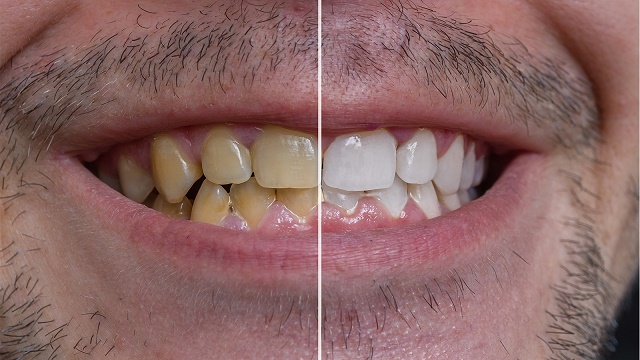

Whether its intrinsic or extrinsic stains, tooth discoloration can cause a tremendous sense of insecurity of most people. That said, tooth discoloration can be a byproduct of many things including health factors, medication, or poor oral hygiene. Generally speaking, tooth discoloration falls into two distinct categories, intrinsic and extrinsic. Stains affecting the enamel are considered intrinsic while extrinsic stains are those that impact the inner structure of the tooth. While there are exceptions, tooth discoloration is not always indicative of a dental problem. In fact, in most cases, stained teeth are very much healthy. In this article, we will take a closer look at what leads to teeth yellowing and other forms of discoloration and also detail a few ways to brighten your smile from the comfort of your own home.
Extrinsic Stains
As noted in the preface of this article, stains that impact one’s tooth enamel are extrinsic stains. Lifestyle is one of the main contributors to this type of staining. For example, tobacco, wine, and coffee are notorious for causing discoloration. It is also worth noting that the foods and drinks that can stain clothes can also stain teeth as well, especially those that are dark in color like chocolate, balsamic vinegar, spaghetti sauces, and certain fruit juices, for example. The same applies to certain fruits and vegetables. While they may be a great source of nutrition, blueberries, pomegranates, and beets, for example, contain chromogens, which can bond to the enamel and cause discoloration. Also, some fruits and vegetables are naturally very acidic and can erode tooth enamel, which, in turn, makes it easier for teeth to become stained.
Intrinsic Stains
Intrinsic stains are more substantial than their extrinsic counterparts in that they occur in the tooth’s dentin, dense bone tissue that makes up nearly the entire tooth. In addition to poor oral hygiene, intrinsic stains can be the result of certain medications like antibiotics, for example. Intrinsic stains are usually brown or yellow and primarily affect the anterior teeth. These stains can also be caused by some prescription-strength mouthwashes like chlorhexidine gluconate, for example. While it is great a killing bacteria and reducing inflammation, long-term use can cause tooth discoloration. In addition to antibiotics and prescription-strength mouthwashes, antipsychotics, antihistamines, and high blood pressure medication are also known to cause discoloration. Another contributor to intrinsic stains is fluoride. Of course, this is not to say that one should avoid fluoride, but it is worth noting that excessive amounts can lead to fluorosis, brown spots that develop beneath the tooth’s surface.
10 Ways to Whiten Yellow Teeth Naturally
Click the next page below to continue reading;
Nollywood actress Ini Edo has expressed her heartfelt message to herself and all mothers in celebration of Mother's Day. The… Read More
Eucharia Anunobi attended the 2025 Africa Magic Viewers’ Choice Awards (AMVCA) in Lagos. She was present as one of the… Read More
John Legend, an award-winning American singer, has expressed his thoughts on Kanye West's mental health and public behavior. Kanye West,… Read More
Mercy Johnson sparked controversy with a viral video of her dancing to the gospel song "Obata." In the video, she… Read More
Nigerian journalist Francess Olisa Ogbonnaya accuses UK-based businesswoman Sandra Duru, also known as Prof Mgbeke, of manipulating the narrative through… Read More
Ice Prince openly discusses his struggle to quit smoking. He highlights that his skill in rolling cannabis complicates his efforts… Read More
This website uses cookies.